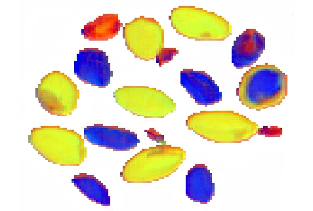Detection of contaminants in rice
Every year we read reports of contaminants in foods. As a consequence companies have to start expensive recalls. That would not be necessary! Hyperspectral imaging allows that the chemical properties of materials are identified and thus differences in the materials can be analysed. The image below shows how a machine vision solution based on hyperspectral imaging detects impurities such as maggots and pieces of would between rice.
The left image shows rice with some chipped wood and some maggots in between. In this image it is very hard to see the impurities. In the middle Chemical Colour Imaging (CCI) was applied to hyperspectral data. Here it can be clearly differentiated between rice (green), wood (blue) and maggots (red).
But using CCI allows to extract much more information of interest. For example the right image shows a segmentation image of the maggots that is streamed in parallel. With the Perception System multible streams can be sent in parallel in real time. This allows to investigate various information at the same time. For example, while the systems scans the rice for impurities, also the moisture of the rice could be monitored.
Chemical Colour Imaging
Hyperspectral camera technology has not yet been widely applied in the industrial environment. Until now, the use of hyperspectral systems has only been accessible to experts in spectroscopy and chemometry.
Chemical Colour Imaging (CCI) allows - for the first time – the analysis of chemical properties by means of real-time image processing. The advantages of spectroscopy and the benefits of machine vision have been merged in a holistic approach.
The core element of CCI is the extraction of two-dimensional feature data - the chemical colour images - from complex, multi-dimensional hyperspectral data. Hyperspectral cube data are described by colour images holding spatial information together with spectroscopic information coded by colour. By adapting a hyperspectral camera with a real-time processing core, Chemical Colour Imaging turns the camera system into an easy-to-understand and intuitive configurable “chemical colour camera”. The chemical colours reflect the molecular properties of the scanned objects.
The advantages of spectroscopy regarding selectivity are extended by the spatial information supplied by imaging systems. A particular benefit is the fact that there is no classification but a targeted reduction of spectroscopic information in order to facilitate the interpretation of chemical properties.







